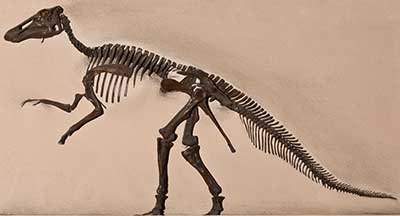Edmontosaurus
(ed-MON-toe-sore-us)
| Quick Facts | |
|---|---|
| Name Meaning: | Edmonton lizard |
| Distribution: | Northwestern America |
| Time Period: | Late Cretaceous, 67 Ma - 65 Ma |
| Length: | 43 ft (13 m) |
| Weight: | 4 tons |
| Diet: | Herbivore |
| Linnaean Classification | |
| Kingdom: | Animalia |
| Phylum: | Chordata |
| Class: | Sauropsida |
| Superorder: | Dinosauria |
| Order: | Ornithischia |
| Family: | Hadrosauridae |
| Genus: | Edmontosaurus |
| Cladistic Classification | |
| |

History
The Edmontosaurus was discovered first in Alberta, Canada. It was named in 1917 by Lawrence Lambe, however, it had been discovered earlier and named by Othniel Charles Marsh in 1892. These specimens were later found to be all part of the same genus and then renamed by Lambe. It was named after the Edmonton formation in which it was discovered. The Edmonton formation is also known as the Horseshoe Canyon Formation, in Alberta, Canada. The dinosaur has had several unique finds due to discovered skin samples and food residue.Description
The Edmontosaurus was, compared to some dinosaurs, a relatively small dinosaur with about the same mass as an elephant. It had powerful jaws, a large body, small forearms, strong back legs, and a large deep tail. Each hand and foot had four fingers. It appeared like the Iguanodon but with a flatter more duck-like beak. Its mouth contained hundreds of small closely packed teeth. The skin above its snout was inflatable, but usually hung in wrinkles over the nasal cavities.Lifestyle
The Edmontosaurus, like many other duckbilled dinosaurs were originally thought to be aquatic due to supposed webbed fingers. This skin on the fingers was later found to be deflated padding like that of modern mammals. The tail would have been too stiff for an aquatic animal and the teeth were built to handle tougher plants than those found in the water. It walked on all fours but could have lifted itself up on two legs for bursts of speed. Because it did not have any natural armor or weapons it would need to flee in dangerous situations. It may have grouped with slow moving herds for protection. The inflatable skin flap above the nasal cavities could have been used to create a resonance in vocal sounds. Paleontologists have a good idea of what it ate due to an excellent find of fossilized seeds, fruits, twigs, and pine-tree needles in the stomach of an Edmontosaurus.
ScienceViews Writer: Jason Hamilton.
Copyright © 2005-2010 Calvin & Rosanna Hamilton. All rights reserved.